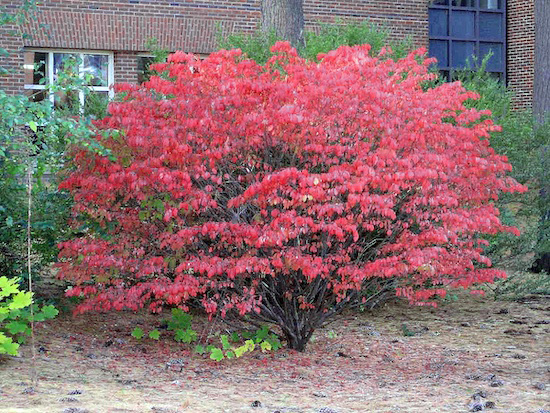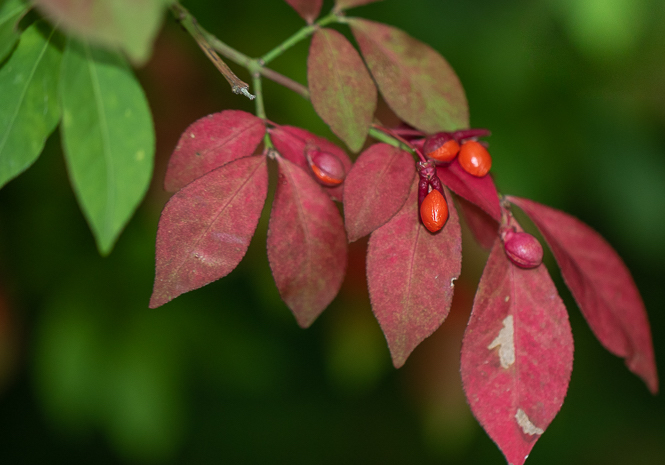Winged Euonymus – This Red is a Warning
by Elaine Homstad, Fairfax Master Gardener

Burning Bush (Euonymus alatus)
In recent decades, awareness of plants that are invasive has grown exponentially. Often, homeowners will have these species in their landscape because they “inherited” them when they purchased a home, or because they were planted at a landscaper or nursery’s suggestion for some desirable characteristic they possess.
Many landscapes, both residential and commercial, contain these plants, and this article will concentrate on the shrub Euonymus alatus, commonly called winged euonymus or burning bush.
Burning bush is an ornamental plant native to northeastern Asia. It was brought to North America in the 1860s for its novelty and distinctive autumn display of brilliant neon-red foliage and colorful berries, as well as its low maintenance. These qualities made it widely cultivated and planted throughout the eastern United States and Midwest. While this may sound desirable, like many other imports they have a much darker side — their invasiveness.
Invasive plants are defined as “species intentionally or accidentally introduced by human activity into a region in which they did not evolve and cause harm to natural resources, economic activity or humans.”
Soon after its introduction, it escaped into the wild and has now naturalized in over 25 states and into Canada. It has invaded woodlands and is now classified as an invasive species in 21 states, including Virginia. It spreads through the dispersion of its seeds, in the form of berries, most frequently eaten by birds and then eliminated as they travel from place to place. Winged euonymus is not particularly picky about where it will grow, tolerating all kinds of soils and being able to thrive in full sun to deep shade. This makes it very troublesome in natural woodlands and forests, growing into large thickets, crowding out other understory plants, and making elimination difficult. This same ease of spread makes it a nuisance in the home landscape, where it will pop up in unwanted spots or invade from a neighbor’s plant, as it has in my own gardens.

Winged Euonymus berries
It is also challenging to get rid of in the home or commercial landscape. Just cutting it to the ground is ineffective, as it will regenerate at a growth rate of 10 to 15 inches per year. The Pennsylvania Cooperative Extension suggests that though it is a prolific seeder, it can be controlled individually, through foliar herbicide treatments from early May into October.
Small young plants can be pulled effectively by hand. With larger plants in low-density invasions, using a garden tool or hoe to remove most of the root system can also be effective. Basal bark and stump herbicide treatments can be used at any time of year.
Once it has been removed (or hopefully never planted) there are great native alternatives. These will provide similar growth habits, fall color and berries for wildlife. These alternatives can also provide more year-round interest, since the invasive burning bush may dazzle in fall, but the rest of the year it is rather non-distinguished, with its multi-branching vase shape and small chartreuse leaves. It can also become quite leggy and barren of foliage on the lower parts of those branches.
Here is a list of recommendations for native alternatives to Euonymus alatus:
- Highbush blueberry (Vaccinium corymbosum)
- American cranberry viburnum (Viburnum opulus var. americanum)
- Strawberry bush (Euonymus americanus)
- Red osier dogwood (Cornus sericea)
- Red or black chokeberry (Aronia arbutifolia or melanocarpa) Also great for wet spots
- Fragrant sumac (Rhus aromatica)
- Winterberry holly (Ilex verticillata)
- Virginia sweetspire (Itea virginica) A personal favorite in sun or shade
The Virginia Department of Conservation and Recreation is an extensive online resource about native and invasive plants, and recommendations for publications and additional information.
- Resources
- Burning Bush, Master Gardeners of Northern Virginia
- Virginia Department of Conservation and Recreation
- Burning Bush, Skylure Templeton, Art Gover, Dave Jackson, and Sarah Wurzbacher Pennsylvania State Extension
- Euonymus Alatus, North Carolina Extension Gardener Plant Toolbox